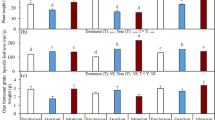Abstract
To predict the consequences of environmental change on the structure and composition of communities, it is necessary to also understand the regional drivers underlying the structuring of these communities. Here, we have taken a hypothesis-based approach to test the relative importance of niche versus neutral processes using niche overlap, species traits and population asynchrony in two crossed treatments of fertilization and grazing in an alpine meadow community. Our results suggested that the observed species biomass overlap was not significantly different between treatments of grazing, grazing × fertilization and grazer exclusion. In contrast, the species biomass overlap was higher than expected in fertilization treatments when grazers were excluded. On the one hand, we found no relationship between species traits and relative abundance in grazing, grazing × fertilization and grazer-exclusion treatments; on the other hand, mechanistic trait-based theory could be used to predict species relative abundance patterns in fertilization treatments when grazers were excluded. From grazing to fertilization, when grazers were excluded, there was a slight increase in species synchrony, which indicated that the complementary dynamic of species gradually changed from complete independence into synchronously fluctuating with increasing fertilization. Based on the above results, we concluded that stochastic and deterministic processes formed ends of a continuum from grazing to fertilization when grazers were excluded in an alpine meadow plant community, and the importance of niche differences between species in structuring grassland communities increased with increasing fertilization and decreased with grazing.





Similar content being viewed by others
References
Aarssen LW, Schamp BS, Pither J (2006) Why are there so many small plants? Implications for species coexistence. J Ecol 94:569–580
Adler PB, HilleRisLambers J, Levine JM (2007) A niche for neutrality. Ecol Lett 10:95–104
Bai Y, Han Z, Wu J, Chen Z, Li L (2004) Ecosystem stability and compensatory effects in the inner Mongolia grasslands. Nature 431:181–184
Bell G (2000) The distribution of abundance in neutral communities. Am Nat 155:606–617
Caswell H (1976) Community structure-neutral model analysis. Ecol Monogr 46:327–354
Chase JM (2005) Towards a really unified theory for metacommunities. Funct Ecol 19:18–186
Chesson P (2000) Mechanisms of maintenance of species diversity. Annu Rev Ecol Syst 31:343–366
Cornelissen JHC, Lavorel S, Garnier E, Diaz S, Buchmann N, Gurvich DE, Reich PB, Ter Steege H, Morgan HD, van der Heijden MGA, Pausas JG, Poorter H (2003) A handbook of protocols for standardized and easy measurement of plant functional traits worldwide. Aust J Bot 51:335–380
Cornwell WK, Ackerly DD (2009) Community assembly and shifts in plant trait distributions across an environmental gradient in coastal California. Ecol Monogr 79:109–126
Farnon Ellwood MD, Manica A, Foster WA (2009) Stochastic and deterministic processes jointly structure tropical arthropod communities. Ecol Lett 12:277–284
Gravel D, Canham CD, Beaudet M, Messier C (2006) Reconciling niche and neutrality: the continuum hypothesis. Ecol Lett 9:399–409
Grime JP (2001) Plant strategies, vegetation processes, and ecosystem properties, 2nd edn. Wiley, Chichester
Grime JP (2006) Trait convergence and trait divergence in herbaceous plant communities: mechanisms and consequences. J Veg Sci 17:255–260
Harpole W, Tilman D (2006) Non-neutral patterns of species abundance in grassland communities. Ecol Lett 9:15–23
Houlahan JE, Currie DJ, Cottenie K, Cumming GS, Ernest SKM, Findlay CS (2007) Compensatory dynamics are rare in natural ecological communities. Proc Natl Acad Sci USA 9:3273–3277
Hubbell SP (2001) The unified neutral theory of biodiversity and biogeography. Princeton University Press, Princeton
Hubbell SP (2005) Neutral theory in community ecology and the hypothesis of functional equivalence. Funct Ecol 19:166–172
Hubbell SP, Foster RB (1990) Structure, dynamics, and equilibrium status of old-growth forest on Barro Colorado Island. In: Gentry AH (ed) Four Neotropical forests. Yale University Press, New Haven, pp 522–541
Keddy PA (1992) Assembly and response rules: 2 goals for predictive community ecology. J Veg Sci 3:157–164
Klein JA, Harte J, Zhao XQ (2007) Experimental warming, not grazing, decreases rangeland quality on the Tibetan Plateau. Ecol Appl 17:541–557
Leibold MA (1995) The niche concept revisited: mechanistic models and community context. Ecology 76:1371–1382
Loreau M, de Mazancourt C (2008) Species synchrony and its drivers: neutral and nonneutral community dynamics in fluctuating environments. Am Nat 172:48–66
Luo YJ, Qin GL, Du GZ (2006) Importance of assemblage-level thinning: a field experiment in an alpine meadow on the Tibet Plateau. J Veg Sci 17:417–424
Mason NWH, Lanoiselee C, Mouillot D, Wilson JB, Argillier C (2008) Does niche overlap control relative abundance in French lacustrine fish communities? A new method incorporating functional traits. J Anim Ecol 77:661–669
Mason NWH, De Bello F, Dolezal J, Leps J (2011) Niche overlap reveals the effects of competition, disturbance and contrasting assembly processes in experimental grassland communities. J Ecol 99:788–796
McGill BJ, Enquist BJ, Weiher E, Westoby A (2006) Rebuilding community ecology from functional traits. Trends Ecol Evol 21:178–185
Mouillot D, Mason NWH, Wilson JB (2007) Is the abundance of species determined by their functional traits? A new method with a test using plant communities. Oecologia 152:729–737
Niu SW, Ma LB, Zeng MM (2008) Effect of overgrazing on grassland desertification in Maqu County. Acta Ecol Sin 28:145–153
Stone L, Roberts A (1992) Competitive exclusion, or species aggregation—an aid in deciding. Oecologia 91:419–424
Suding KN, Collings SL, Gough L, Clark C, Cleland EE, Gross KL, Milchunas DG, Pennings S (2004) Functional and abundance-based mechanisms explain diversity loss due to N fertilization. Proc Natl Acad Sci USA 102:4387–4392
Sugihara G, Bersier LF, Southwood TRE, Pimm SL, May RM (2003) Predicted correspondence between species abundances and dendrograms of niche similarities. Proc Natl Acad Sci USA 100:5246–5251
Tilman D (1999) The ecological consequences of changes in biodiversity: a search for general principles. Ecology 80:1455–1474
Tilman D (2004) Niche tradeoffs, neutrality, and community structure: a stochastic theory of resource competition, invasion, and community assembly. Proc Natl Acad Sci USA 101:10854–10861
Ulriarte M, Reeve HK (2003) Matchmaking and species marriage: a game-theory model of community assembly. Proc Natl Acad Sci USA 100:1787–1792
Vergnon R, Nicholas K, Fleckleton R (2009) Niches versus neutrality: uncovering the drivers of diversity in a species-rich community. Ecol Lett 12:1079–1090
Vogwill T, Fenton A, Brockhurst MA (2009) Dispersal and natural enemies interact to drive spatital synchrony and decrease stability in patchy populations. Ecol Lett 12:1194–1200
Volkov I, Banavar JR, HubbelL SP, Maritan A (2003) Neutral theory and relative species abundance in ecology. Nature 424:1035–1037
Weiher E, Clarke GDP, Keddy PA (1998) Community assembly rules, morphological dispersion, and the coexistence of plant species. Oikos 81:309–322
Westoby M, Falster DS, Moles AT, Vesk PA, Wright IJ (2002) Plant ecological strategies: some leading dimensions of variation between species. Annu Rev Ecol Evol 33:125–159
Wu GL, Du GZ, Liu ZH, Thirgood S (2009) Effect of fencing and grazing on a Kobresia-dominated meadow in the Qinghai-Tibetan Plateau. Plant Soil 319:115–126
Yang ZL, Van Ruijven J, Du GZ (2011) The effects of long-term fertilization on the temporal stability of alpine meadow communities. Plant soil doi:10.1007/s 11104-011-0784-0
Zhou SR, Zhang DY (2006a) Neutral theory in community ecology. Acta Phytoecol Sin 30:868–877
Zhou SR, Zhang DY (2006b) Allee effects and the neutral theory of biodiversity. Funct Ecol 20:509–513
Acknowledgments
We thank Dr. Jacob Weiner and Charlotte Chang for helpful discussions and comments on the manuscript; Dr. Peng Jia for assistance with the data analysis; Dr. Shujun Wen, Dr. Xin Chen, Dr. Wei Li, Dr. Chunhui Zhang, Dr. Xiaoming Shi, Yuanzhen Zhu, Liujie Wang, Xiao Yang, Wenxiang Hu, and many others at the Maqu Rangeland Workgroup for assistance in both the field and lab. This project was supported by the Key Program of the National Natural Science Foundation of China (grant no:40930533). These experiments comply with current laws of China.
Author information
Authors and Affiliations
Corresponding author
Additional information
Communicated by Melinda Smith.
Rights and permissions
About this article
Cite this article
Yang, Z., Guo, H., Zhang, J. et al. Stochastic and deterministic processes together determine alpine meadow plant community composition on the Tibetan Plateau. Oecologia 171, 495–504 (2013). https://doi.org/10.1007/s00442-012-2433-6
Received:
Accepted:
Published:
Issue Date:
DOI: https://doi.org/10.1007/s00442-012-2433-6




